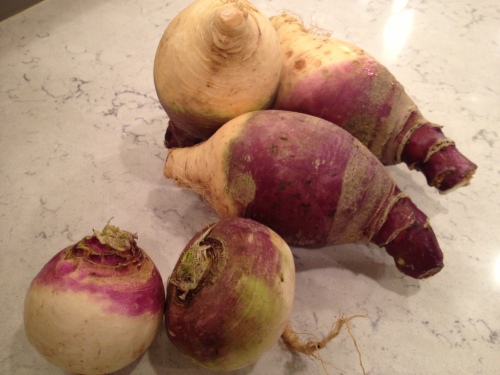After yesterday’s topic of discussion (which has triggered quite the mind-bending conversation over in the comments) I feel the need to return to a subject that’s a tad easier to wrap my head around. What is the difference between a turnip and a rutabaga?
When I posed this question to Dad he muttered, “Swedes?” and then something about cattle feed. According to Wikipedia, it’s common in the north of England (Dad’s original stomping grounds) to call a rutabaga (aka the ‘swede’ – from ‘Swedish turnip’) a turnip. Dad’s reference to cattle feed is a standard comment delivered whenever I mention certain easily grown vegetables which, apparently, were deemed unfit for human consumption by Brits during WWII. Kale, collards, turnips, and parsnips are the main culprits and if the Queen would never deign to eat cattle food, then why should he?
Unfit for human consumption isn’t quite right – it seems to have been more that things were so bad during the war people were reduced to eating fodder more often consumed by cattle and hogs. Though Dad now eats collard greens, turnips, and rutabags, he draws the line at kale. Steamed, baked, or served up as chips- kale remains in the cattle feed bucket as far as he’s concerned, regardless of kale’s current status as a super food.
Back to the question at hand, what is the difference between turnips and rutabagas?
According to Niki Jabour’s very good book,
The Year-Round Vegetable Gardener: How to Grow Your Own Food 365 Days a Year, No Matter Where You Live I’m not the only one a bit confused about the exact differences. Both are in the cabbage family with bulbous roots and the varieties I’m familiar with sport the same colour scheme (white toward the root end and pink blooming into a deep purple toward the greens end). Turnips, though, are smaller and rounder (Niki harvests hers 6-8 weeks after seeding). Rutabagas are BIG (they can be up to six inches across) and take much longer to mature. In both cases, you can eat the greens (we harvested all manner of brassica greens last year and sold them in our early goody boxes as braising greens – delicious!)
Niki suggests sowing turnips in cold frames late in the winter and then continuing to sow out in the garden from late April through mid-August. Rutabagas, on the other hand, she treats as a once a year crop, planted in early summer and harvested in the fall after 3-4 months of growth. Turnips can be eaten raw (I’ve never tried this, but Dad remembers snacking on them as a child… though if he called Swedes (actually rutabagas) turnips, then I’m not entirely sure what he called a turnip…) Rutabagas are generally cooked first.
We’ve used baby greens in salads but like most of the brassica family, they soon develop quite a strong taste and, when fully mature, can be bitter. Coat in butter or olive oil and add your savoury seasoning of choice and then sautee with garlic and perhaps a few onions and yum! A tasty veggie side dish.
I just stumbled across a recipe for mashed rutabagas and carrots, which I plan to try soon to take advantage of the gorgeous organic carrots Liz has been growing down at the end of the road. So good! We’ve been using them in salads, smoothies, and roasted – mashed with rutabagas sounds like a cool addition to the list of carrot prep options.












I have realized that i’ve never eaten a rutabaga before, don’t know if i’ve even seen one! I’m going to track one down. Leave no vegetable unsampled.
A friend of mine posted on facebook recently a really cool illustrated guide to “weird” vegetables and what to do with them. I’ll see if i can find it..
LikeLike
I’d like to see that… I’m always curious to learn about ‘weird’ vegetables… It’s interesting how few varieties of even our most common vegetables we actually eat…
LikeLike
I’d never heard of rutabagas until I came across it in a book. We’d call them swedes too. My father and then my husband both refused to eat them, so I don”t think I’ve ever had one.
LikeLike
I grew up eating lots of turnip greens. They were a staple in the diet around here (we called it simply “salad” or “sallet”). But I don’t recall eating turnips and (to the best of my knowledge) I’ve never had a rutabaga. I’ve been growing turnip greens for years (we grow a variety of turnip that produces great greens and not so great roots) but these year we also planted some turnips proper as well. Had no idea now delicious they were! We’ll be growing a lot more of them this year.
LikeLike
Enjoy! They are very tasty! Here, we had the opposite experience, not realizing how good the greens are until quite recently!
LikeLike
From the U of IL extension service…
“Turnips grow wild in Siberia and have been eaten since prehistoric times. Rutabagas are a cross between cabbage and turnip.”
http://urbanext.illinois.edu/veggies/turnip.cfm
I’ve never grown either. Not sure I have eaten either, either. 🙂
LikeLike
Thanks for the link… Who knew turnips (and rutabagas) were so interesting? It’s never too late to try something new, particularly in the vegetable department…
LikeLike
I’m willing. We just aren’t very adventurous. Stick with the tried and true. That’s not a good excuse, I know.
LikeLike
My favorite thing to do with a rutabaga is chop it up and boil it along with potatoes when making mashed potatoes. (Or, since they take a long time to cook, you can put the rutabaga on to cook a little before the potatoes, and then add the cooked chunks when you are at the mashing stage.) It adds a delicious earthy taste to the potatoes without being overpowering. My kids always loved that mix too.
LikeLike
Gosh, rutabagas were always on my mom’s Thanksgiving table, next to the mashed potatoes. Never liked them. What I hated more was peeling and cutting them as they are so hard. Turnips were never made in our home, but they were in the “soup” veggie pack sometimes, and so they got tossed in when mom made soup.
LikeLike
I put raw turnips, raw beetroot and raw swede (rutabaga) in my morning smoothie…………….delicious!
LikeLiked by 1 person
Oh yum! I can relate – I throw all sorts of things into my smoothies and they are generally delicious!
LikeLike